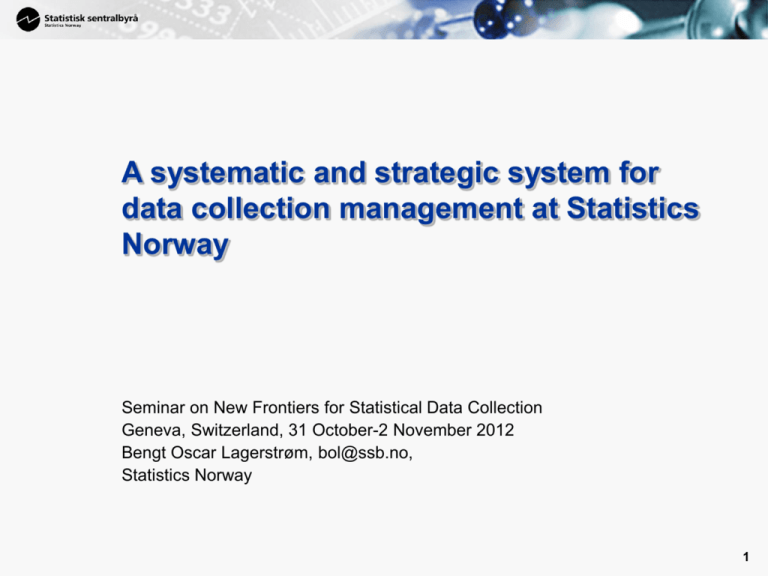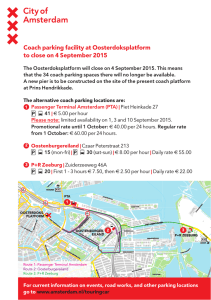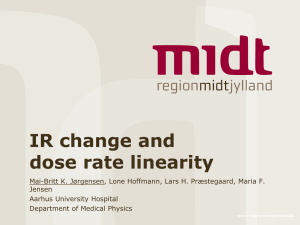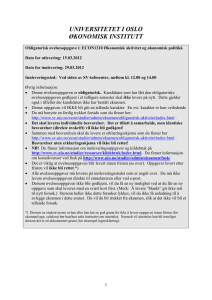Prosedyrer i ESS
advertisement

1 A systematic and strategic system for data collection management at Statistics Norway Seminar on New Frontiers for Statistical Data Collection Geneva, Switzerland, 31 October-2 November 2012 Bengt Oscar Lagerstrøm, bol@ssb.no, Statistics Norway 1 Outline • Background • What is a action plan? • Use of action plans • Results • Conclusion/Further works 2 Background • Increasing emphasis on quality management – Total quality management, continuous quality improving, six sigma, and so forth • At the same time, our industry have experienced – Increased non response rates, and – (much) higher survey costs 3 Respons rates, Norway Utvikling i svarandeler i noen utvalgte personundersøkelser 100 90 AKU 80 Valg Prosent 70 LKU-t EU-Silc 60 ESS 50 Forbruk 40 Tidsbruk 30 20 10 0 1967 1970 1973 1976 1979 1982 1985 1988 1991 1994 1997 2000 2003 2006 2009 År 4 Quality in data collection • ”Number of ton produced” – Number of interview started – Item non-response – ……. • Optimal planning – How many interviewers and when? – Reduction of non-scheduled stops – Organization of good flow 5 Lean philosophy • Is about – – – – – structuring, operating, controlling, managing, and continuously improving (our data collection) 6 Action plans and Lean • Purpose: Make a environment for – reducing costs – increase efficiencies, and – improve our products/statistics • How? – Reducing “waste” – “Only one time” – Organize and standardizes 7 Why action plans? • A tool for designing and manage data collection within an allocated resource limit • A tool to monitor that actions leads to better quality given a set of resources • Documentation • But most of all, a tool for making a (different) culture around a data collection – Improved competence through more systematically and strategic approaches 8 What is a action plan? • A description of the planning and implementation of the set of process that make a data collection – Quality indicators – Demming’s quality wheel (PDCA) • • A preparation for both anticipated and unexpected challenges A documentation – Of actions and results • A communication strategy – Who is responsible for what and when? • Adjust Plan Check Do A monitoring system – indicators • A guidance – For next wave or a different survey 9 Action plans • Goals and key figures • Actions – Before and during the field period – What to do, when and who? • Indicators – – – – response rate, contact rate, recruitment rate, r-indicator etc. 10 Goal Er målet nådd? ja 2. januar. Start nei 9. januar intervju 640 Ja 16. januar 920 intervju Ja 30. januar 1140 intervju 6. februar 1200 intervju Ja, 1227 Mål 60% intervju (anslag på ca 25 avganger) , utvalg 2000, 16-79 år. Antall intervju 1200 Antall minutter: 11 minutter i gjennomsnitt. 11 Actions before the field period starts TILTAK Hvordan? Når? Innen Status og vurdering IO-brev med noteringshefte Brev sendt ut, Marit 29.11.2011 Ok Påminningsbrev Brev sendt ut, Marit 28.12.2011 Ok Sende telefonbrev til de med fasttelefon Brev sendes med påminningsbrev, Marit 28.12.2011 Nummerkobling Telefinn og DM-huset, Thore Uke 48 1644 telefonnummer (82,2%) Manuell sporing 356 lagt inn i siv + eget excel-ark for sporing, Arnhild Uke 48. 5 IO til frafall. 351 forsøkt sporet. Fant 262 (74,6%) Utsending IO-brev til ”returer” Oppdaterte adresser og sendt påminningsbrev, Marit 28.12.2011 OK Oppstartmøte feltplan. Kom vi greit i gang? Bemanning CATI/lokale Marit, Arnhild, Tor Før utsending 12 Actions during the field period, part 1 Etter utsending Start Jytte 2. januar 2000 IO lastet i SIV. 1906 m/tlf (95,3%) 17 nektere, 1 langvarig syk og 2 avganger før start (1%) Sjekk av cati-management innstillinger Rune 2. januar Ok Sjekke at riktige variabler kommer opp i ringebildet / intervjuerlønn kan føres Arnhild/intervjuer 2. januar Ok Oppdatering av Intervjuersiden Marit/Arnhild 2. januar ok Brifing, Oslo + Supervisorer Marit/Arnhild 2. januar Ok Brifing, Kvg. Marit/Tor 3. januar Ok 1. sjekkpunkt. Er vi i rute? Antall statuser, intervju, timeforbruk. Mål 640 intervju (400t) 8 intervju per økt 9. januar 317 timer, 590 intervjuer Sjekkpunktsmøte Marit/Bengt CAPI IO uten nummer sendes til lokale intervjuere. Lillian 11. januar 9. januar 13 Actions during the field period, part 2 2. sjekkpunkt. Er vi i rute? Antall statuser, intervju, timeforbruk, Mål 920 intervju 350/(350t cati/ 50 timer capi) 5 intervju per økt, supervisor Marit/Bengt 16. januar 907 intervjuer, 197 timer 1. runde nektere Utvalgte intervjuere (bemanningstiltak). Arnhild 23. januar Sendes ut 19 jan 219 IO SMS Alle NB! Kode 35 Jytte/Arnhild 16. januar Fremskynder fra 23. januar til 16. januar-OK CAPI - oppfølging Lillian 23. januar 3. sjekkpunkt: Er vi i rute? Antall statuser, intervju, timeforbruk. Mål om 1120 intervju (250t cati/50 capi) 3 intervju per økt Supervisor Marit/Bengt 30. januar 2. runde nektere Utvalgte intervjuere (bemanningstiltak), Arnhild 6. februar SMS Jytte/Arnhild 30. januar Ferdig. Mål: 1300 intervju 250t/1250t) Evaluering av tiltaksplan + ny HP 6. februar Marit/Bengt 1130 intervju 1227 intervju (61,9%), 948 timer 20. mars 14 Indicators Goal Last quarter Check 1 Check 2 Check 3 Result Response rate 60 58 62 Contact rate 75 75 75 Recruitment rate 80 78 82 R-indicator 0.8 0.74 0.71 15 Results, Omnibus • Shorter field period – from 6-7 weeks to 5 • • • • Less interviewer hours Standardized procedures Steady state No jumping! Contact rate Recrutement rate Response rate 2010 79 70 56 2011 77 76 58 2012* 74 78 58 R-indicator 0.77 0.74 0.76 16 Results, LFS • Shift in ‘mode’ between 2. and 3 quarter 2011 (from decentralized CATI to centralized CATI) – New challenges (questionnaire, contact strategies) • • • Standardized procedures Steady state No jumping! Contact rate Recrutement rate Response rate R-indicator 1. quarter 2011 0,90 0,96 0,864 2. quarter 2011 0,9 0,94 0,846 3. quarter 2011 0,88 0,95 0,836 4. quarter 2011 0,86 0,95 0,817 1. quarter 2012 0,85 0,95 0,8075 2. quarter 2012 0,86 0,95 0,817 0,81 0,81 0,82 0,82 17 Conclusions • Standards for planning, communication, reporting, correction, documentation and evaluation of the field period – Especially surveys with less complexes structures, few involvements (persons), or high degree of repetitive actions • Further work – Look for more similar iterative processes in different surveys – Work more with the teams (communication and standardization) – Not only steady state, but also continuous improvement Higher response rate Lower bias Lower cost 18 Thank you for your attention! Bengt Oscar Lagerstrøm, bol@ssb.no, Statistics Norway 19


